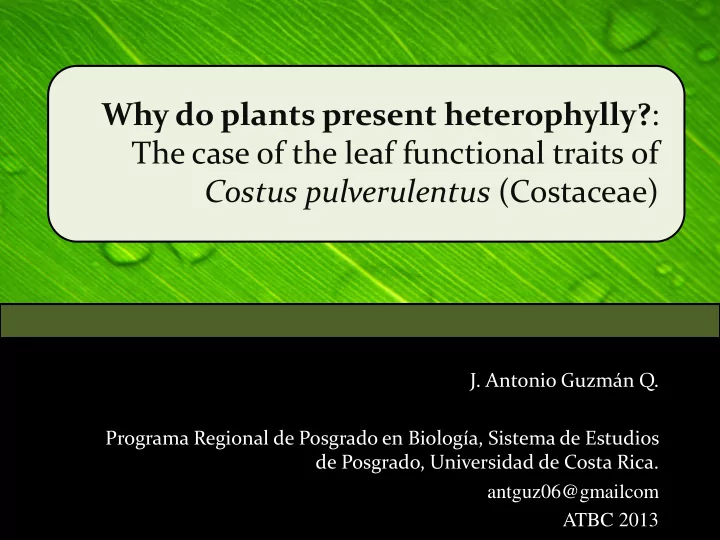

Why do plants present heterophylly? : The case of the leaf functional traits of Costus pulverulentus (Costaceae) J. Antonio Guzmán Q. Programa Regional de Posgrado en Biología, Sistema de Estudios de Posgrado, Universidad de Costa Rica. antguz06@gmailcom ATBC 2013
Phenomenon of heterophylly “Changes in leaf size and shape along the axis of the individual (Winn 1999 )” • Derives from genetic control or their plasticity • Possible “strategy” t0 acclimatization and adaptation Introduction
Costus species • Some species present changes in leaf size ( Kirchoff & Rutishauser 1990) • But these authors and taxonomists do not describe as possible conditions of heterophylly Introducción
Study Questions 1. C. pulverulentus present heretophylly? 2. Which can be its adaptive value? Study Questions
Specie and site of study • CEEC Dr. Alvaro Wille Trejos • Wet Tropical Forest • Costus pulverulentus Methods
Specie and site of study • CEEC Dr. Alvaro Wille Trejos • Wet Tropical Forest • Costus pulverulentus Methods
Methods Leaf morphological analysis 1 2 3 Changes along Light capture the crown efficiency
Methods 1. Leaf morphological analysis First sample (n= 20) Three leaves were selected: 1 • Upper • Middle • Lower Landmarcks (2 points) and Semilandmarcks (26 points) Procrustes transformación PCA and ANOVA 2 3
Methods 2. Changes along the crown Second sample (n=30): 1 • Divergence angles • Leaves areas • Specific leaf area • Leaf area relations Standardization of the position in the crown (First leaf = 0 ; Last leaf = 1 ) 2 3 𝑂𝑀 𝑓 = 𝑂𝑀 − 1 𝑂𝑀 𝑢 − 1
Methods 3. Light capture efficiency Same second sample (n= 30) 1 Two leaves shape were selected: • Top-shape • Basal-shape Plant achitecture Pearcy & Yang (1996) STAR (Duursma et al. 2012 ) 2 3
Leaf morphological analysis Upper-crown Lower-crown Middle-crown PC1 : F 2, 57 = 52.62, p <0.001 PC2 : F 2, 57 = 1.72, p = 0.18 Fig. 1. PCA from the procrustes transformation Results and Discussion
Thin plate splines Basal shape Top shape Middle-crown Upper-crown Lower-crown Base and Apex Leaf sheet C. pulverulentus has heterophylly !!! Results and Discussion
Changes along the crown Divergence angle (deg) r 2= 0.21 r 2 = 0.41 400 150 y = 270.71 - 142.61 x + 164.77 x 2 y = 92.90 - 214.72 x + 180.48 x 2 200 SLA (cm2 g-1) LA (cm2) 100 100 300 50 0 r 2=0.34 200 y = 90.26 + 298.51 x - 306.10 x 2 0 0.0 0.2 0.4 0.6 0.8 1.0 0.0 0.2 0.4 0.6 0.8 1.0 0.0 0.2 0.4 0.6 0.8 1.0 NL e NL e NL e LA = leaf area SLA =speficic leaf area NL e = Leaf number standardized Fig. 3. Divergence angle, leaf size and specific leaf area along the crown Results and Discussion
Relationships between leaf areas 200 3750 3750 B C A 160 LA m (cm2) LA t (cm2) LA t (cm2) 2500 2500 120 r 2= 0.17 1250 1250 r 2= 0.75 r 2= 0.63 80 y = 83.22 + 3.57 x y = -673.68 + 185.31 x y = -744.71 + 19.26 x 8 12 16 20 24 8 12 16 20 24 80 120 160 200 Nº leaves Nº leaves LA m (cm2) A: F 1,29 = 86.31, p < 0.001 B: F 1,29 = 5.57, p = 0.025 LA T = Total leaf area C: F 1,29 = 47.67, p < 0.001 LA M = Mean leaf area Fig. 4. Relations of total leaf area, Results and Discussion mean leaf area and leaf number
Light capture efficient Basal shape Top shape 0.5 a Basal-shape Top-shape b 0.45 0.4 STAR (m2 m-2) STAR (m2 m-2) 0.3 0.40 0.2 0.35 0.1 0.30 0.0 8 12 16 20 24 Basal Top Nº of leaves Leaf Shape F 1,59 = 90.48, p <0.001 Fig. 5. STAR according to the type and Results and Discussion number of leaves
Light capture efficient Basal shape Top shape Basal-shape Top-shape 0.45 STAR (m2 m-2) 0.40 0.35 0.30 8 12 16 20 24 Nº of leaves F 1,59 = 90.48, p <0.001 Fig. 5. STAR according to the type and Results and Discussion number of leaves
Why have a basal morphology if top morphology is more efficient? 10 LA (cm2) 1 0.1 Basal-shape Top-shape 10 Leaf length (cm) “This result might be the responsible for the production of basal leaf morphologies in early plant development” Fig. 6. Relationship between leaf length Results and Discussion and leaf area
The case of C. pulverulentus • C. pulverulentus has heterophylly • Mid-crown has a greater space utilization for resource acquisition • To increase leaf area the plant increases leaf size • Adaptation to minimize self-shading Conclusions
Acknowledgment • Coordinators of Biología de Campo Course at UCR • Roberto A. Cordero • R. Duursma • CEEC Dr. Alvaro Wille Trejos
Photo by R. Aguilar Thank you very much for your attention … PURA VIDA!!
Recommend
More recommend